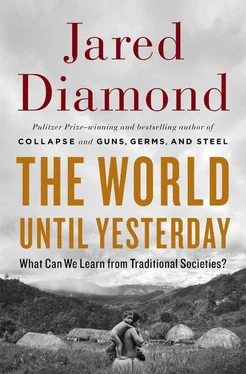We can observe how those four conditions are satisfied by the groups I’ve just mentioned as approaching the extreme of exclusive territories and defended boundaries. My New Guinea mountain friends have a significant investment in their year-round gardens, pigs, and forests, which traditionally gave them everything that they needed. Clearing forests and developing gardens are laborious for them, and are even more so for western New Guinea’s Dani, who dig and maintain elaborate systems of ditches to irrigate and drain their gardens. The Iñupiat and Ainu occupy rich year-round territories with abundant marine resources of salt-water fish, seals, whales, and seabirds, fresh-water fisheries and waterfowl, and inland areas with terrestrial mammals to hunt. Arnhem Land’s Yolngu similarly lived in dense populations made possible by the combination of productive coastal and inland resources. Owens Valley’s Shoshone Indians were hunter-gatherers living at relatively high densities in an area with ample water that let them irrigate land to increase its yields of edible wild grass seeds, and that provided storable harvests of pine nuts. Those food stores, pine groves, and irrigation systems were worth defending, and there were enough Owens Valley Shoshones to defend them. Finally, Yanomamo Indians maintain plantations of peach palm and plantain trees that produce their staple foods for many years and are also worth defending.
In areas with especially large and dense populations, such as those of the Dani and the Sudan’s Nuer, not only are there separate groups each with its own territory, but those territorial groups are further organized into hierarchies of three or more levels. Those hierarchies remind us of the hierarchical organization of land, people, and political control familiar to us in our modern state societies, starting with individual house plots, and ranging up through cities, counties, and states to the national government. For instance, the Nuer ( Plate 7), numbering 200,000 people in an area of 30,000 square miles, are divided into tribes of 7,000 to 42,000 people each, each tribe divided and subdivided into primary and secondary and tertiary subtribes, down to villages of 50 to 700 people and separated by 5 to 20 miles. The smaller and hierarchically lower the unit, the fewer are the disputes about boundaries and other matters, the stronger are the pressures that relatives and friends bring to bear on disputants to settle disputes quickly and without violence, and the more limited is any fighting that does occur. For instance, the Nuer observe few restrictions in their treatment of neighboring Dinka tribes: they regularly raid the Dinka, steal Dinka livestock, kill Dinka men, and take home some Dinka women and children as captives while killing the others. But Nuer hostilities against other Nuer tribes consist only of sporadic cattle raids, killing of just a few men, and no killing or kidnapping of women and children.
The opposite extreme of less or no exclusivity is approached under conditions that are the mirror image of the conditions selected for exclusivity. One such condition is sparse and small populations that make patrolling (other than casually looking for trespassers while out doing other things) impossible. For instance, a society consisting of just a single family can’t afford dedicated patrols, because it can’t have its single adult man spending all day seated at the top of a watch-tower. A second condition involves unproductive, marginal, variable environments with sparse and unpredictable resources, such that any territory one might feasibly claim would often (at some seasons or in a bad year) not contain essential resources, and one would then periodically have to seek resources in another group’s territory and vice versa. Third, it doesn’t pay to risk one’s life defending a territory containing nothing worth dying for: if one’s territory is attacked, it would then be preferable just to move to another area. Finally, territories are likely to be non-exclusive if group membership is fluid, and if group members often visit or transfer to other groups. It makes no sense to keep out another group if half of its members are visitors or transferees from your own group anyway.
However, the usual form of land division under these conditions selecting for non-exclusivity isn’t the extreme of a free-for-all in which anybody can do anything anywhere. Instead, it still is the case that each group is identified with a specific core area. Non-exclusive societies differ from exclusive societies in that, instead of the Dani no-man’s land clearly delineated by watch-towers, recognized borders don’t exist, and land ownership just becomes increasingly vague as one moves increasing distances from one’s core area. Another distinction of non-exclusive from exclusive societies is that neighboring groups receive permission to visit your territory more often and for more different purposes—especially to obtain food and water at certain seasons or in certain years. Correspondingly, you can readily obtain permission to visit your neighbor’s territory when you are the one in need, so the arrangement becomes an exchange based on reciprocity and mutual benefit.
An example of non-exclusive land ownership that has been described in detail is the !Kung hunter-gatherers (Plate 6) of the Nyae Nyae area of the Kalahari Desert. When studied in the 1950s, they consisted of 19 bands, containing between 8 and 42 people per band, each band with its own “territory” (termed a n!ore ) of between about 100 and 250 square miles in area. But boundaries between n!ores were vague: as anthropologists and !Kung informants walked together from the informants’ camp towards the next n!ore, the informants became increasingly uncertain, or disagreed increasingly with each other, about which n!ore they were now in, the further they got from the center of their n!ore. There were no watch-towers or ridge-line trails to mark n!ore boundaries.
!Kung n!ores are occupied non-exclusively because it is both necessary and possible to share n!ores’ resources. Resource sharing is necessary because water in the Kalahari Desert is scarce, and each band needs to spend much of its time near a waterhole. But there is unpredictable variation in rainfall between years. Many waterholes in the area go dry in the dry season. Only 2 waterholes in the area never failed during the period studied; 3 more were usually available throughout the year but failed in some years; 5 more lasted only occasionally through the dry season; and 50 were seasonal and always went dry for part of the year. Hence in the dry season, up to 200 people from various bands gather at a permanent waterhole with the permission of its owners, who in turn are permitted to visit and use resources of other n!ores when those are abundant. Thus, water considerations require the !Kung to have non-exclusive territories: it would be pointless to claim exclusive use of an area if that area might run out of water and thus become useless. Conversely, the seasonal superabundance of some resources permits non-exclusivity: it is pointless to offend potentially useful allies by keeping them out of your territory at a time when it is producing far more food than you yourself can eat. That’s especially true of the food staple of mongongo nuts seasonally available in enormous crops, and it’s also true of seasonal crops of wild beans and melons.
Supposedly, anyone from any band in the Nyae Nyae area can hunt anywhere, including outside of his own band’s n!ore. However, if you kill an animal outside your n!ore, you should give a present of its meat if you then encounter a member of the band owning that n!ore. But that freedom of access for hunting doesn’t apply to !Kung hunters from more distant areas. More generally, neighboring !Kung bands can readily obtain permission to use each other’s n!ore for other purposes as well, such as obtaining water, nuts, beans, and melons—but they must first ask for permission, and they incur an obligation to reciprocate later by permitting the hosts to visit the visitors’ n!ore. Fighting is likely to break out if they don’t ask for permission. More distant bands have to be especially careful in requesting permission, and should limit the length of their visit and the number of people visiting. Outsiders who have no recognized connection by blood or marriage to the n!ore’s owners cannot visit at all. Thus, non-exclusive territories certainly don’t mean a free-for-all.
Читать дальше










